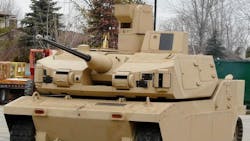Army set to approach industry for prototype unmanned robotic teleop combat vehicle with automatic cannon
WARREN, Mich. – U.S. Army unmanned combat vehicle experts are considering an unmanned ground vehicle (UGV) with onboard 20-to-50-millimeter automatic cannon that can fight alongside infantry and destroy enemy armored personnel carriers, trucks, and troops.
Officials of the Ground Vehicle Systems Center (GVSC) of the U.S. Army Combat Capabilities Development Command (CCDC) in Warren, Mich., may issue a call for white papers as early as this month to kick off the Robotic Combat Vehicle-Medium (RCV-M) project.
The RCV-M will be an attritable unmanned platform augment infantry with direct fire capability and on-board sensors, with a common chassis and tailorable modular mission payloads.
This unmanned combat vehicle should be able to keep pace with infantry and other armored vehicles during off-road maneuver and movement on paved streets and highways.
The Robotic Combat Vehicle-Medium will transportable aboard C-130 H/J aircraft, and be combat ready within 15 minutes after landing. It will have three operational modes: teleoperation, autonomous via waypoint navigation, and leader-follower mode using government-furnished software.
The RCV-M will be able to carry a payload that weighs at least 5,400 pounds, have silent drive to minimize its acoustic and infrared signatures, and extended battery-powered silent watch capability. It will be able to infiltrate enemy terrain to attack armored personnel carriers, trucks, and troops using its on-board Medium Caliber Turret – 30 (MCT-30), which can be fitted with a variety of large automatic cannon ranging from 25 to 50 millimeters.
Army vetronics experts will release a call for white papers as early as 28 June 2019 to the National Advanced Mobility Consortium (NAMC) in Warren, Mich. Requests for prototype proposals will come later. More information on joining or contacting the NAMC is online at www.defensemobility.org.
The Army eventually will ask NAMC members to provide four RCV-M non-developmental prototypes for test and evaluation. The vehicle will have 360-degree situational awareness and sensors for obstacle avoidance.
Related: Military closer to developing smart bullets for machine guns
From industry, the Army wants answers to five questions:
-- Does an NDI platform serve as the foundation for your proposed approach to develop an Robotic Combat Vehicle-Medium? If so, what is the base platform and what are the proposed modifications?
-- Does a prototype or demonstrator of your proposed approach exist or is the platform near completion? If so, will you demonstrate its capabilities at your facility for the Army?
-- If the Army provides four MCT-30 medium caliber turrets for integration, what is the earliest you could deliver the vehicles?
-- If you provide a turret of your own choosing when is the earliest you could deliver the vehicle;
-- What are the primary drivers to schedule risk?
Companies interested should email answers to these questions no later than 14 June 2019 to the Army's Larry Ross at [email protected].
For questions or concerns contact the Army's Monique Lara by email at [email protected], or by phone at 586-467-6065.
More information is online at https://www.fbo.gov/notices/d4e1d737897cd628a70a5612403cc5e6.

John Keller | Editor-in-Chief
John Keller is the Editor-in-Chief, Military & Aerospace Electronics Magazine--provides extensive coverage and analysis of enabling electronics and optoelectronic technologies in military, space and commercial aviation applications. John has been a member of the Military & Aerospace Electronics staff since 1989 and chief editor since 1995.

